Study of the Influence of Winding and Sensor Design on Ultra-High Frequency Partial Discharge Signals in Power Transformers
Abstract
1. Introduction
2. Simulation Model
2.1. Winding Design
2.2. Sensor Design
2.3. Test Setups
3. Results
3.1. Influence of Winding Design
3.1.1. Simplified Single-Phase Model
3.1.2. Power Transformer Model
- At t = 8 ns, in the third winding design, the EM waves have already exited the winding through the gaps in the outer layer windings and reached the closest sensors (sensors 8 and 17). However, in the reference design, the EM waves are still inside the winding and hence, they take a longer time to reach the closest sensors.
- At t = 16 ns, in the third design, the EM waves have reached the central winding (winding block V) and propagated through the gaps in the outer layer windings. Whereas in the reference winding design, the EM waves have just exited winding block W and reached the closest sensors to the left of the winding.
- As time elapses and the EM waves propagated along the length of the tank, the differences between the two cases become less pronounced. For example, at t = 40 ns, there is no marked difference in the propagation between the two winding designs.
3.2. Influence of Sensor Design
4. Conclusions
5. Outlook
Author Contributions
Funding
Conflicts of Interest
References
- Dukanac, D. Application of UHF method for partial discharge source location in power transformers. IEEE Trans. Dielect. Electr. Insul. 2018, 25, 2266–2278. [Google Scholar] [CrossRef]
- Judd, M.D.; Yang, L.; Hunter, I.B.B. Partial discharge monitoring of power transformers using UHF sensors. Part I: Sensors and signal interpretation. IEEE Electr. Insul. Mag. 2005, 21, 5–14. [Google Scholar] [CrossRef]
- Ishak, A.M.; Judd, M.D.; Siew, W.H. A study of UHF partial discharge signal propagation in power transformers using FDTD modelling. In Proceedings of the 45th International Universities’ Power Engineering Conference, UPEC 2010, Cardiff, Wales, UK, 31 August–3 September 2010; Institution of Engineering and Technology: London, UK, 2011; pp. 1–5, ISBN 978-1-4244-7667-1. [Google Scholar]
- Antoun, C. High voltage circuit breaker and power transformer failure modes and their detection. In Proceedings of the Condition Monitoring and Diagnosis (CMD), Perth, WA, Australia, 23–26 September 2018; IEEE: New York, NY, USA, 2018; pp. 1–6, ISBN 978-1-5386-4126-2. [Google Scholar]
- Küchler, A. High Voltage Engineering. Fundamentals-Technology-Applications; Springer Vieweg: Berlin, Germany, 2018; ISBN 978-3-642-11993-4. [Google Scholar]
- Wang, Z.; Li, J.; Sofian, D.M. Interpretation of transformer FRA responses—Part I: Influence of winding structure. IEEE Trans. Power Deliv. 2009, 24, 703–710. [Google Scholar] [CrossRef]
- Nobrega, L.; Costa, E.; Serres, A.; Xavier, G.; Aquino, M. UHF partial discharge location in powertransformers via solution of the Maxwell equations in a computational environment. Sensors 2019, 19. [Google Scholar] [CrossRef] [PubMed]
- Du, J.; Chen, W.; Cui, L.; Zhang, Z.; Tenbohlen, S. Investigation on the propagation characteristics of PD-induced electromagnetic waves in an actual 110 kV power transformer and its simulation results. IEEE Trans. Dielect. Electr. Insul. 2018, 25, 1941–1948. [Google Scholar] [CrossRef]
- Zheng, S.; Li, C.; He, M. The influence of windings on UHF electromagnetic wave propagation. In Proceedings of the 2012 IEEE International Conference on Condition Monitoring and Diagnosis (CMD), Bali, Indonesia, 23–27 September 2012; IEEE: New York, NY, USA, 2012; pp. 609–612, ISBN 978-1-4673-1020-8. [Google Scholar]
- Zhao, X.; Cheng, Y.; Meng, Y.; Wu, K.; Niu, Y. The propagation characteristics of UHF partial discharge in power transformers with complex winding structure. In 2012 Annual Report Conference on Electrical Insulation and Dielectric Phenomena, Proceedings of the IEEE Conference on Electrical Insulation and Dielectric Phenomena—(CEIDP 2012), Montreal, QC, Canada, 14–17 October 2012; IEEE: New York, NY, USA, 2012; pp. 60–63. ISBN 978-1-4673-1252-3. [Google Scholar]
- Cruz, J.D.N.; Serres, A.J.R.; de Oliveira, A.C.; Xavier, G.V.R.; de Albuquerque, C.C.R.; da Costa, E.G.; Freire, R.C.S. Bio-inspired printed monopole antenna applied to partial discharge detection. Sensors 2019, 19. [Google Scholar] [CrossRef] [PubMed]
- Xavier, G.V.R.; Serres, A.J.R.; da Costa, E.G.; de Oliveira, A.C.; Nobrega, L.A.M.M.; de Souza, V.C. Design and application of a metamaterial superstrate on a bio-inspired antenna for partial discharge detection through dielectric windows. Sensors 2019, 19. [Google Scholar] [CrossRef] [PubMed]
- Drexler, P.; Čáp, M.; Fiala, P.; Steinbauer, M.; Kadlec, R.; Kaška, M.; Kočiš, L. A Sensor system for detecting and localizing partial discharges in power transformers with improved immunity to interferences. Sensors 2019, 19. [Google Scholar] [CrossRef] [PubMed]
- Zachariades, C.; Shuttleworth, R.; Giussani, R. A dual-slot barrier sensor for partial discharge detection in gas-insulated equipment. IEEE Sens. J. 2019, 1. [Google Scholar] [CrossRef]
- Siegel, M.; Beltle, M.; Tenbohlen, S. Characterization of UHF PD sensors for power transformers using an oil-filled GTEM cell. IEEE Trans. Dielect. Electr. Insul. 2016, 23, 1580–1588. [Google Scholar] [CrossRef]
- Gulski, E.; Koltunowicz, W.; Tenbohlen, S. Guidelines for partial discharge detection using conventional (IEC 60270) and unconventional methods. In Cigre Technical Brochure 662; CIGRE: Paris, France, 2016. [Google Scholar]
- Beura, C.P.; Beltle, M.; Tenbohlen, S. Positioning of UHF PD sensors on power transformers based on the attenuation of UHF signals. IEEE Trans. Power Delivery 2019, 34, 1520–1529. [Google Scholar] [CrossRef]
- Tenbohlen, S.; Beura, C.P.; Beltle, M.; Siegel, M. UHF sensor placement on power transformers for PD monitoring. In Proceedings of the CIGRE Colloquium SCA2 /SCB2/ SCD1, New Delhi, India, 21–22 November 2019; CIGRE: Paris, France, 2019. [Google Scholar]
- Beura, C.P.; Beltle, M.; Tenbohlen, S. Attenuation of UHF Signals in a 420 kV Power Transformer Based on Experiments and Simulation. In Proceedings of the 21st International Symposium on High Voltage Engineering, Budapest, Hungary, 26–30 August 2019; Németh, B., Ed.; Springer International Publishing: Cham, Switzerland, 2020; pp. 1276–1285, ISBN 978-3-030-31679-2. [Google Scholar]
- Siegel, M.; Beltle, M.; Tenbohlen, S.; Coenen, S. Application of UHF sensors for PD measurement at power transformers. IEEE Trans. Dielect. Electr. Insul. 2017, 24, 331–339. [Google Scholar] [CrossRef]
- Akbarzadeh, A.R.; Shen, Z. On the gap source model for monopole antennas. Antennas Wirel. Propag. Lett. 2008, 7, 115–118. [Google Scholar] [CrossRef]
- Beura, C.P.; Beltle, M.; Tenbohlen, S.; Siegel, M. Quantitative analysis of the sensitivity of UHF sensor positions on a 420 kV power transformer based on electromagnetic simulation. Energies 2020, 13, 3. [Google Scholar] [CrossRef]
- Coenen, S.; Tenbohlen, S.; Markalous, S.; Strehl, T. Sensitivity limits of UHF PD measurements on power transformers. In Proceedings of the 16th International Symposium on High Voltage Engineering, Cape Town, South Africa, 24–28 August 2009; SAIEE: Johannesburg, South Africa. [Google Scholar]
- Cap, M.; Drexler, P.; Kaska, M. Comparison of methods for detecting the signal arrival time in TDOA localization method. In Proceedings of the Progress in Electromagnetic Research Symposium (PIERS), Shanghai, China, 8–11 August 2016; IEEE: New York, NY, USA, 2016; pp. 1813–1816, ISBN 978-1-5090-6093-1. [Google Scholar]
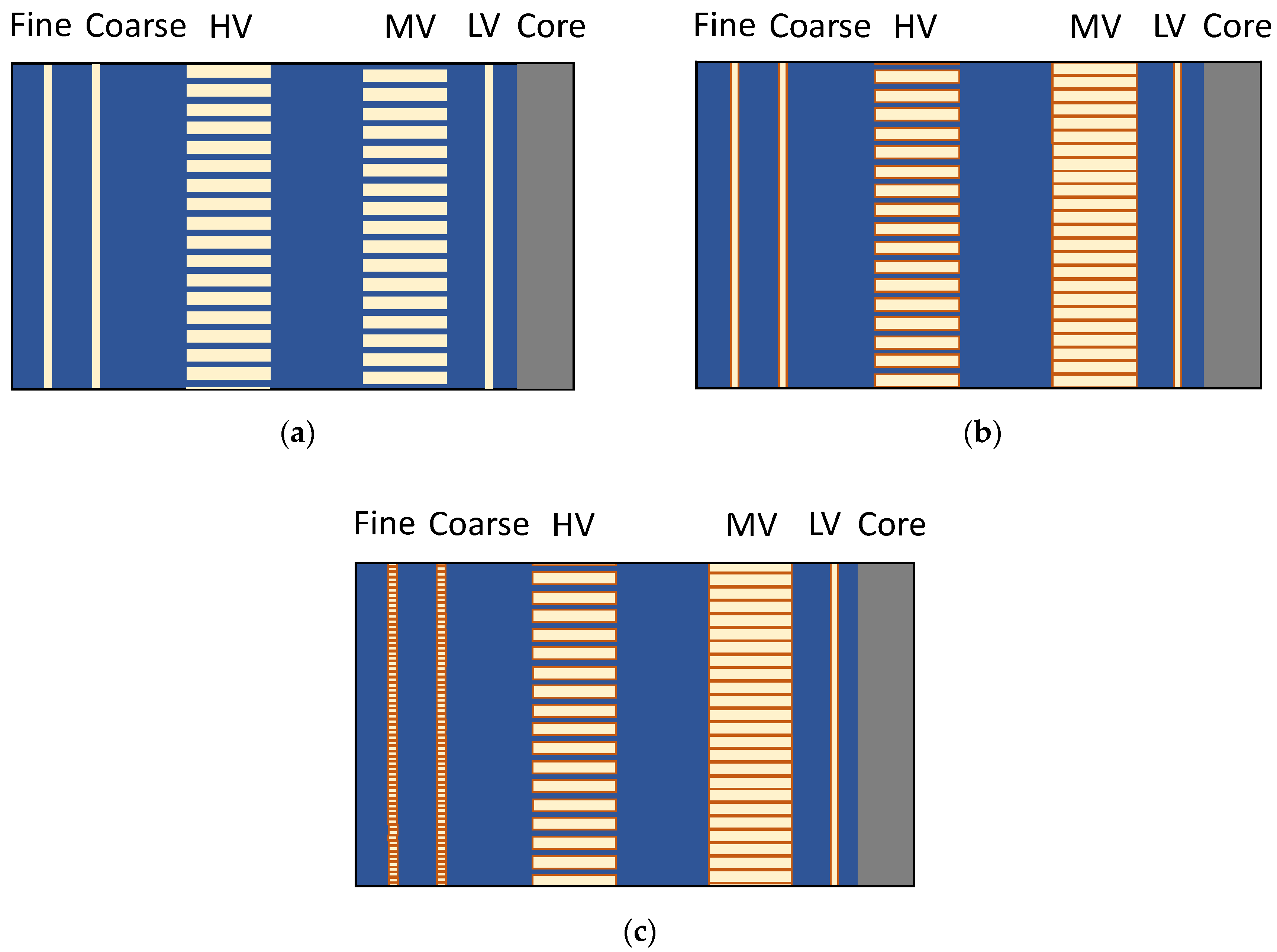


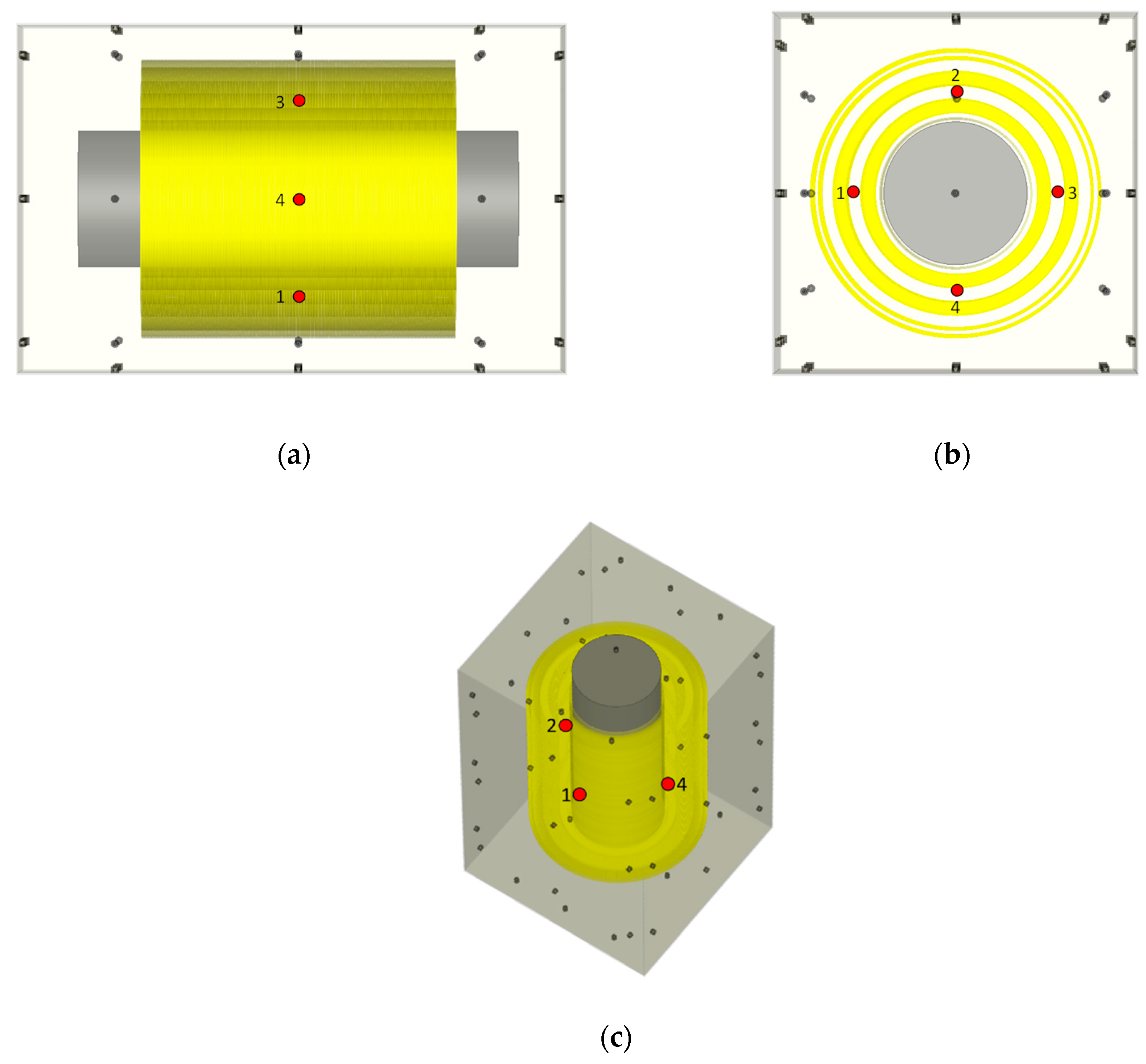
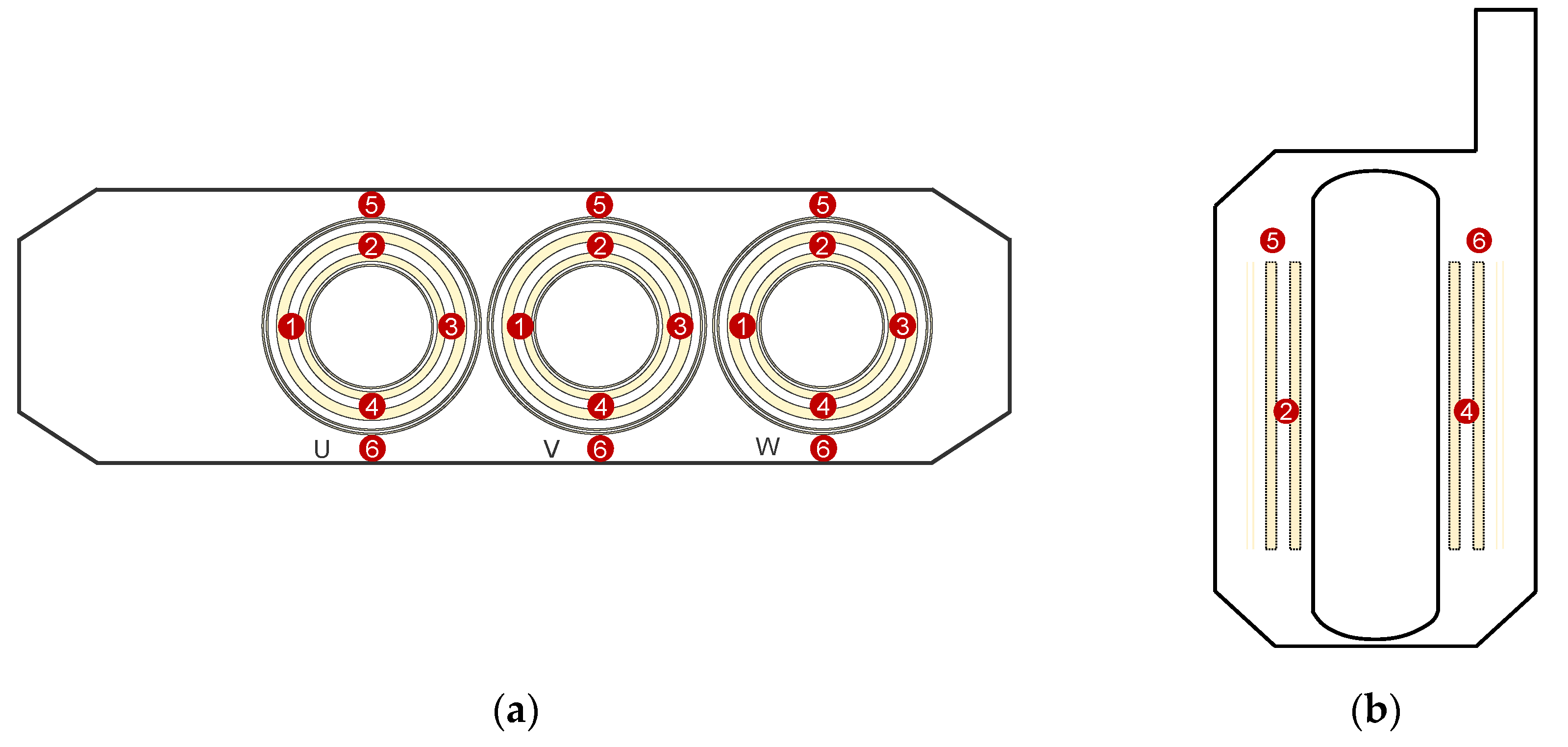


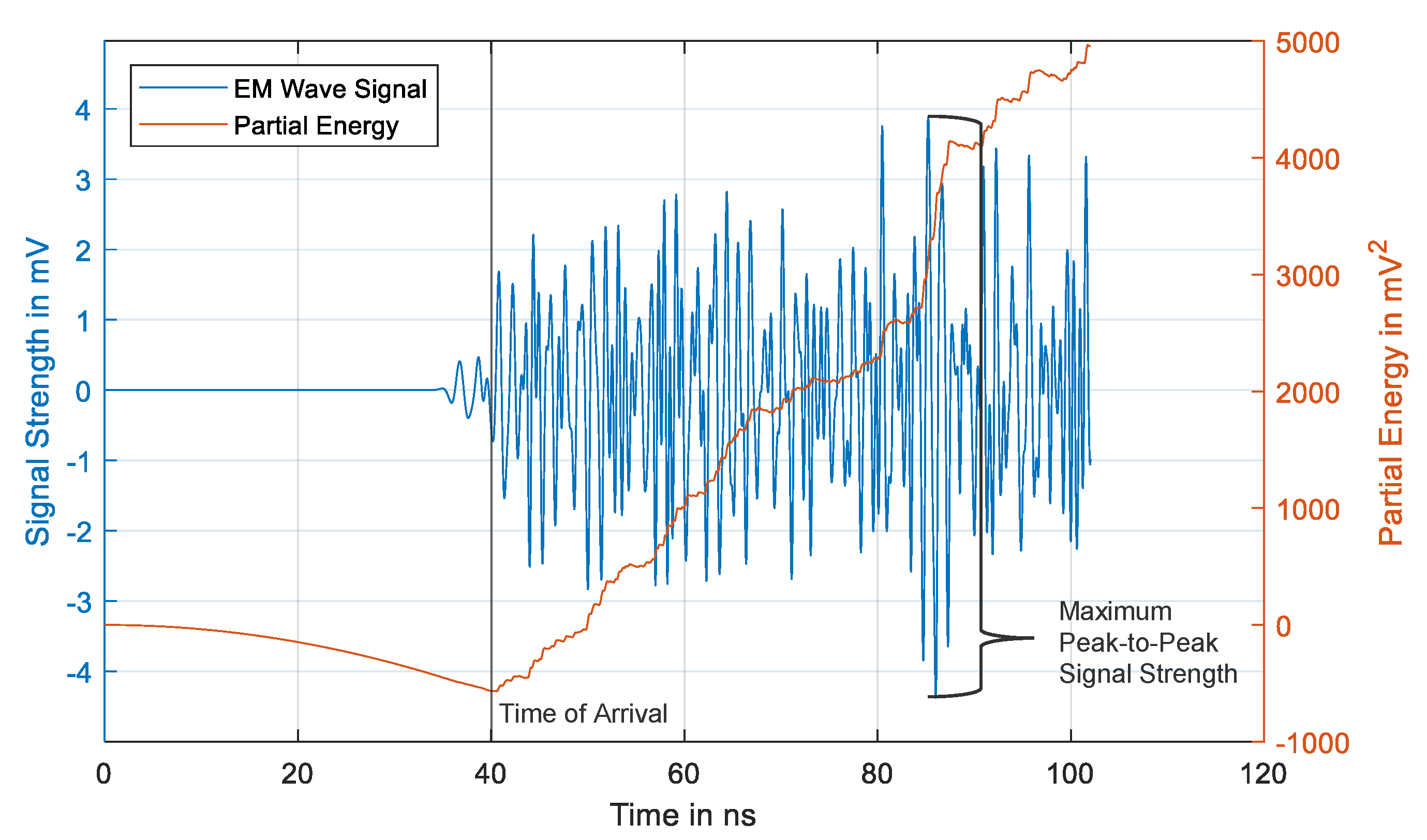

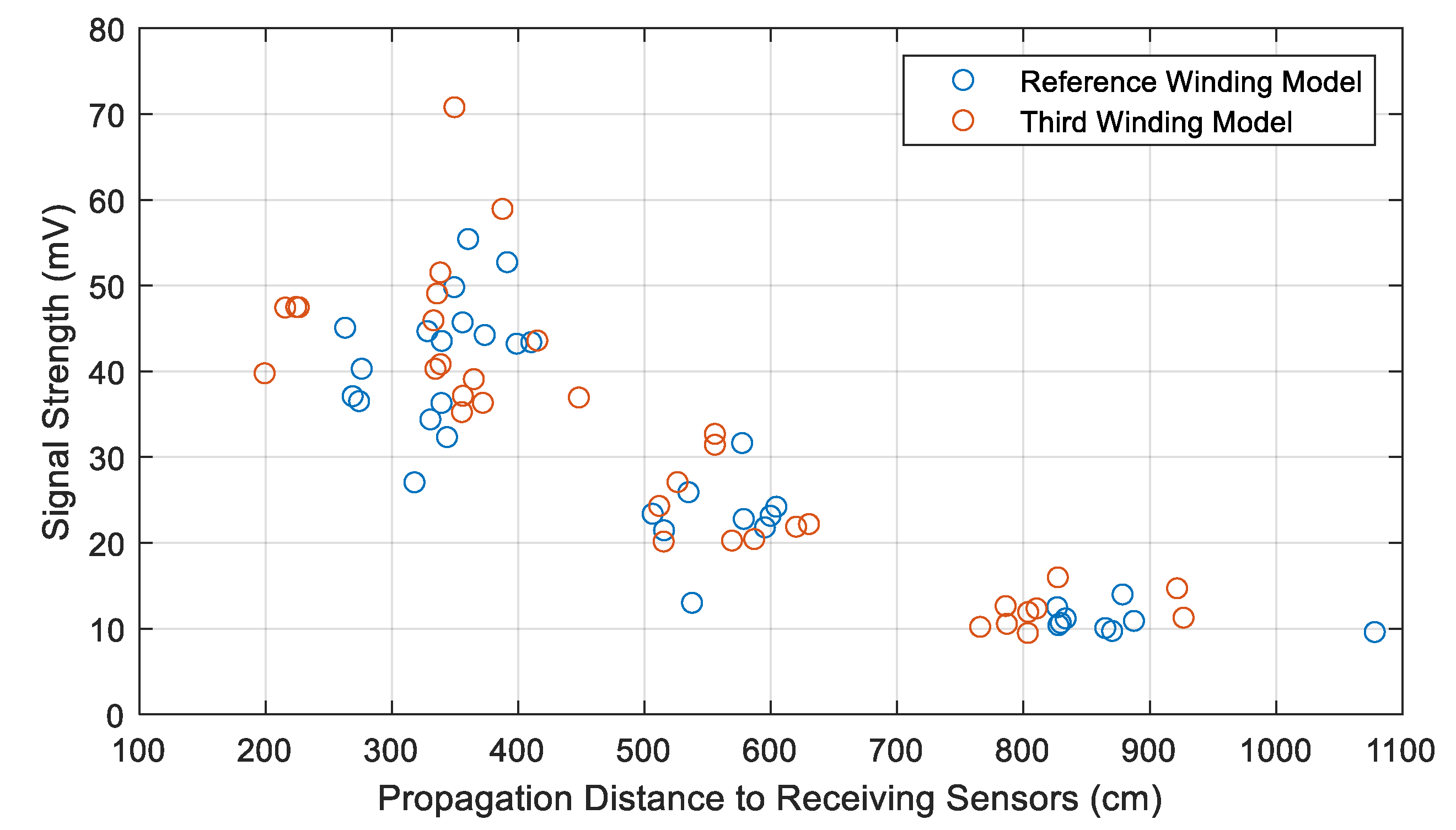
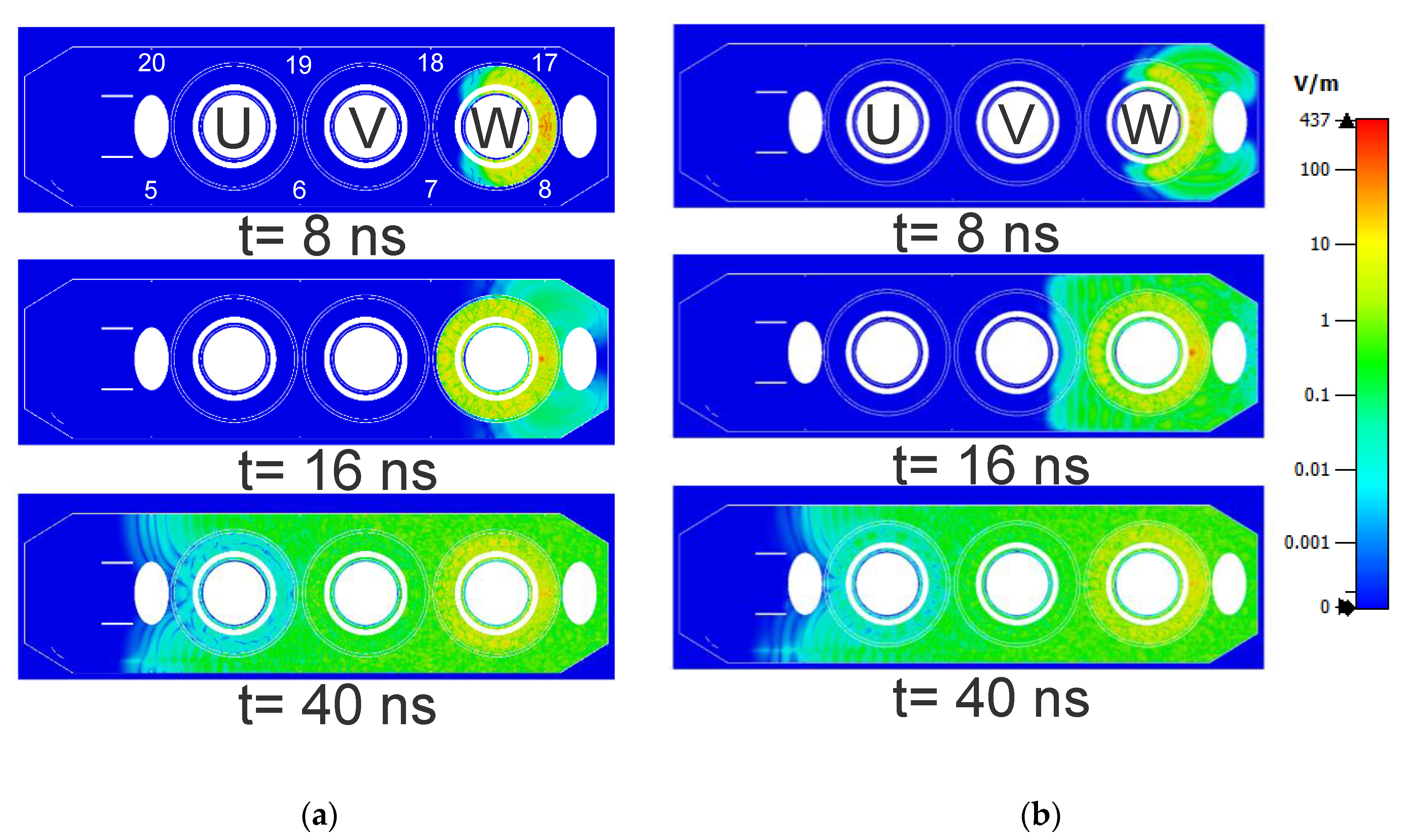



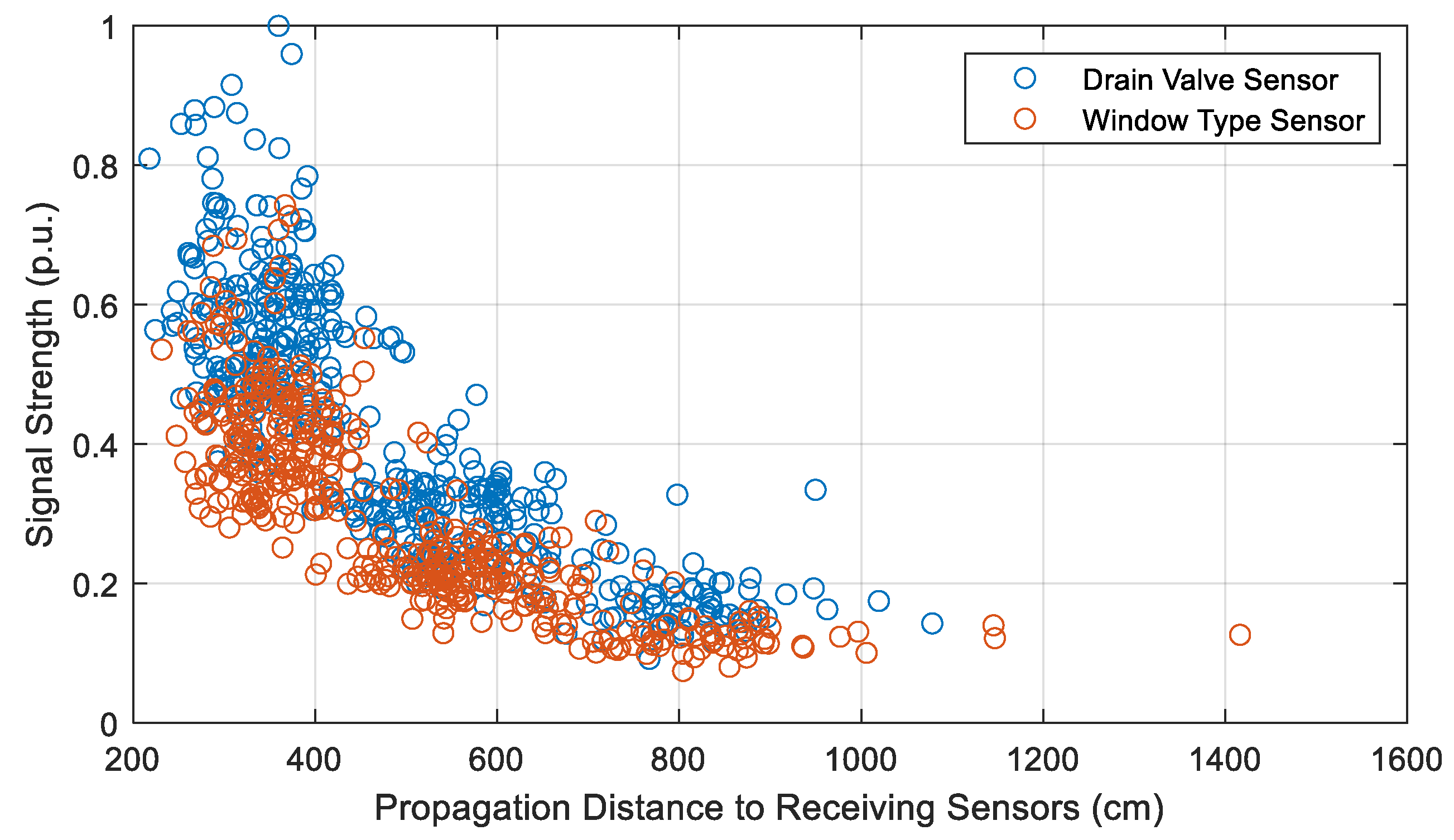
© 2020 by the authors. Licensee MDPI, Basel, Switzerland. This article is an open access article distributed under the terms and conditions of the Creative Commons Attribution (CC BY) license (http://creativecommons.org/licenses/by/4.0/).
Share and Cite
Beura, C.P.; Beltle, M.; Tenbohlen, S. Study of the Influence of Winding and Sensor Design on Ultra-High Frequency Partial Discharge Signals in Power Transformers. Sensors 2020, 20, 5113. https://doi.org/10.3390/s20185113
Beura CP, Beltle M, Tenbohlen S. Study of the Influence of Winding and Sensor Design on Ultra-High Frequency Partial Discharge Signals in Power Transformers. Sensors. 2020; 20(18):5113. https://doi.org/10.3390/s20185113
Chicago/Turabian StyleBeura, Chandra Prakash, Michael Beltle, and Stefan Tenbohlen. 2020. "Study of the Influence of Winding and Sensor Design on Ultra-High Frequency Partial Discharge Signals in Power Transformers" Sensors 20, no. 18: 5113. https://doi.org/10.3390/s20185113
APA StyleBeura, C. P., Beltle, M., & Tenbohlen, S. (2020). Study of the Influence of Winding and Sensor Design on Ultra-High Frequency Partial Discharge Signals in Power Transformers. Sensors, 20(18), 5113. https://doi.org/10.3390/s20185113





